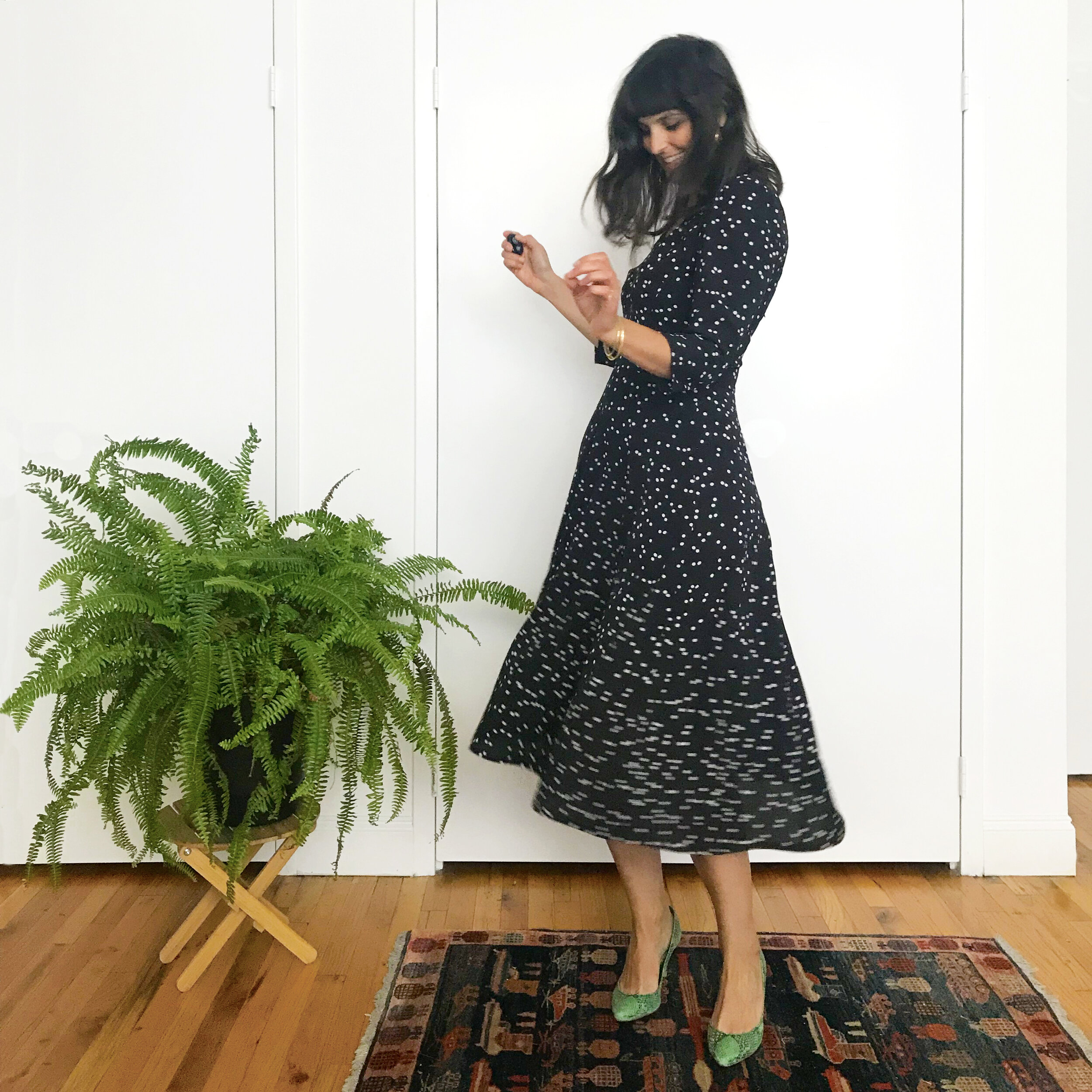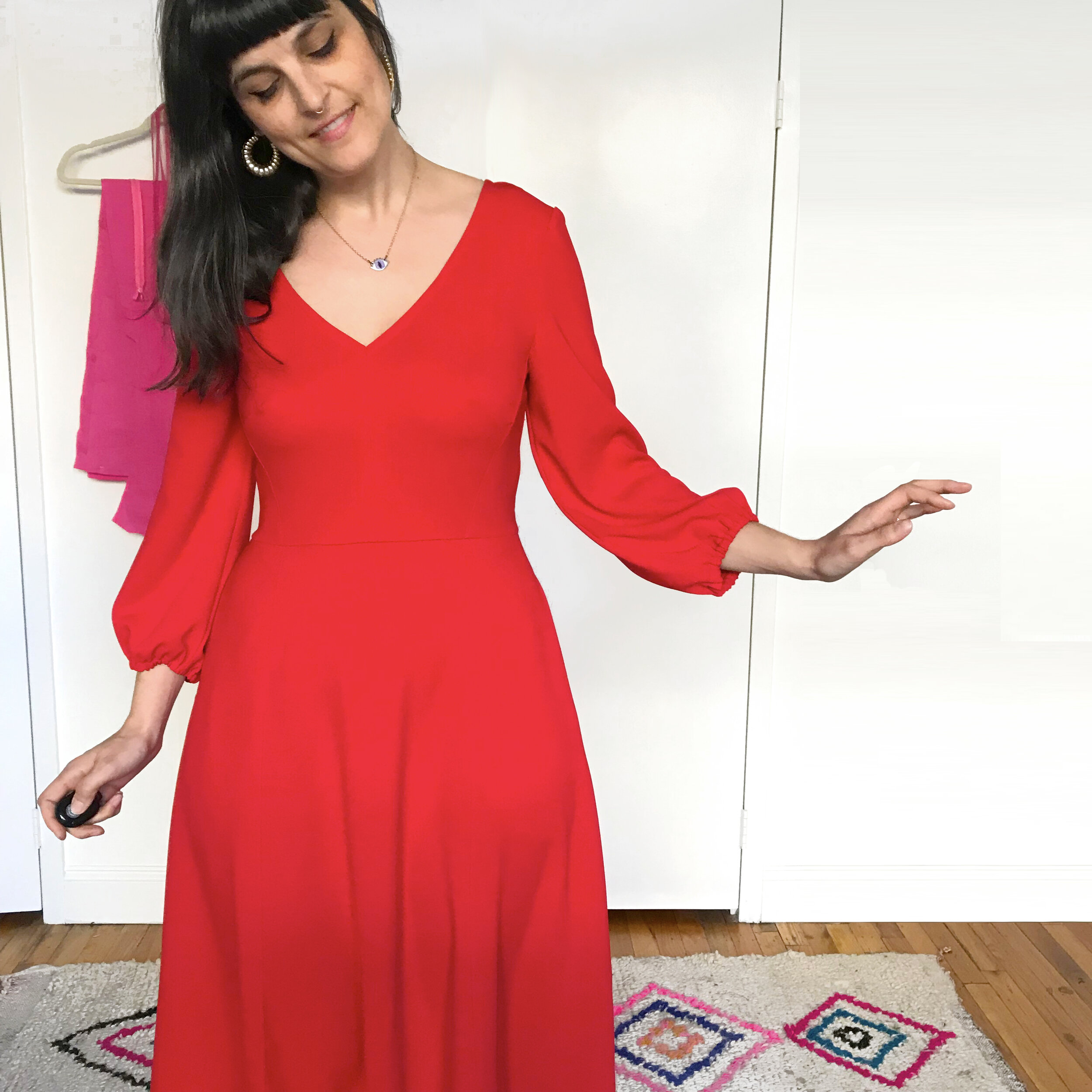CUTOUT BACK DRESS - VOGUE 9328 IN REFORMATION VISCOSE CREPE
This is my third time sewing Vogue 9328 (and the first project I put on my 2020 sewing list). Right when it was released, I saw so much potential in this pattern - my first thought was that it just needed a dramatic sleeve and a ruffle hem to approximate The Vampire’s Wife, or could be left as is to get a look similar to a few other brands that have been making simple yet special dresses with long narrow sleeves. I still love the pattern (hence the multiple versions), but I’ve learned some important lessons about fabric selection as I’ve gone.
My first version was a cheap fabric. Now, I love a bargain, and can sometimes find gorgeous silk for as little as $5/yard in New York’s Garment District. That’s not what I mean. It was cheap, not inexpensive. It was a polyester crepe with a tiny touch of stretch, in a perfect scattered polka dot pattern. I wore it quite often, but never washed it (I didn’t even prewash the fabric). Before long, the seams were slipping, literally causing the dress to fall apart, and it had pilled evenly, all over the dress (even areas that never rubbed against anything), which looked and felt gross. I was sad to watch a lovingly homemade dress devolve so quickly.
For my second version, I used a more luxurious fabric, in bright red. That dress is lovely, but wearing fitted, bright red dress, feels overtly sexy to me in a way that makes me a bit uncomfortable in my own skin. So it’s been living at the back of my closet.
And yet! I was not willing to give up on this pattern. BACK TO THE DRAWING BOARD!
This time around, I knew I needed to find a fabric that I love, that felt special, and that had an every-day-super-wearable feeling. When this fabric debuted on Emma One Sock, I didn’t even hesitate, I bought 3 yards immediately. (Sorry, it is now sold out! But her site always has incredible fabrics.) Emma One Sock is a textile jobber (like Mood), meaning designers sell them extra fabric they have leftover after production, and Emma One Sock can then re-sell the fabric to home sewers. This fabric is from Reformation (I found the dress online). It’s a lovely, crepey viscose. Personally, I don’t like to use rayon (pretty much the same thing as viscose), but this fabric has a pebbley texture that I liked.
This pattern is a Vogue Easy Options pattern and is rated “Easy”. Personally, I don’t think Vogue Patterns are ever intended to be for beginners, but instead target more experienced home sewers. So, I think this pattern is easy, but it is not beginner friendly, mostly because of the bias bound neckline and circular back cutout. It takes some patience to get the circular cutout bound in a way where it still lays flat. I used drapey, squiggley fabric for all three of my versions, which I think makes the project a bit more difficult, with the payoff of a swishy, drapey dress.
This viscose was pretty annoying to work with; it really wanted to unravel and go off grain at any opportunity. I finished my interior seams with my serger’s narrow 3 thread overlock stitch. I also made my own bias binding so that the binding would drape in the exact same way as the rest of the dress. I made a tutorial on making your own bias binding, which I prefer to do whenever using a special fabric.
My fitting modifiactions to this pattern were minimal. I began with my usual Vogue Patterns size, 12. This pattern includes cup size options, which is awesome because it eliminates any need for a Full Bust Adjustment. I used the included chart to calculate my cup size (C), which has nothing to do with what size bra you wear - use the chart (and consider making a muslin). I lowered the bust dart 1/2” (I usually lower it 1”), and have found that pressing the bust dart on a tailors ham will get you the best shaping for this pattern.
I lengthened the bodice 1/2” (I usually lengthen it 1”), and if I made this again, I wouldn’t lengthen it at all. So keep an eye on that if you have a shorter torso. I lengthened the skirt 1”, and I usually lengthen skirts anywhere from 1” to 12”, depending on what look I’m going for.
Here you can see how I finished the edge of the enlarged opening and added a skinny bow at back neck.
Using a fold over ruffle at the sleeve hem ensures the wrong side of the fabric is never visible while wearing the dress.
For design changes, I eliminated the flounce at the sleeve hem, because having fabric flapping around like that sometimes irritates me (I hate stuffing them into a coat), and because I didn’t want the wrong side of my fabric showing. Instead, I added a 1.5” ruffle, which was folded over, and has the right side of the fabric showing on both sides. I also enlarged the back cutout by simply extending the opening upward. I removed 1.25” total from the center, where the pattern has a seam connecting the left and right sides of the bodice. Now that the 2 sides don’t connect, I added a narrow, bias cut spaghetti strap to tie in a bow at center back neck.
Overall, I am super pleased with how this dress came out. I wish the bodice was that 1/2” shorter, but now that I’ve typed this out, I’ll remember to change that next time. My only complaint about this pattern is that it is difficult to get the circular back cut out to lay flat and not be distorted, when using the suggested fabrics. In a stable fabric like cotton or linen, it would be a snap, but then the dress wouldn’t have the soft drape that I think makes the design work. I would consider making this again with no cut out in the back at all. Because of the princess seams, there are many places to tweak the fit of this bodice, which makes it pretty versatile, and I love the shape of the neckline.
I am a little worried about how this fabric will hold up over time. I am hard on my clothes! I really wear them! I’ve worn this dress for the better part of a day now, and I can feel that the fabric has relaxed (typical of rayon and viscose), which I do not prefer, as it makes the fit looser. After my first version of this dress fell apart, I’m more weary than ever of syntetic fabric. But I have to remind myself, it is a designer fabric, and they likely tested it for longevity.
Alright, that’s enough musing for now. I’ve gotta get back to this game of musical chairs. Let me know if you try this pattern! XO Martha









